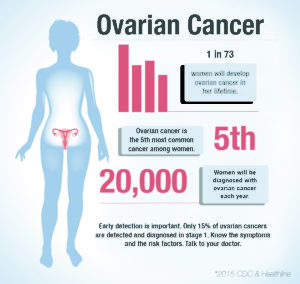Ovarian cancer is a type of cancer which begins in the ovaries of a woman. The female reproductive system contains two ovaries, one on the left side of the uterus and the other on the right. The ovaries are about the size of an almond and they produce the hormones estrogen and progesterone but their primary role is the production of eggs or ova for fertilization. Detecting ovarian cancers can be a daunting task because they often show no symptoms and by the time ovarian cancer is considered as a possible cause of some symptoms, it usually has already spread to other parts of the body.
- bloating.
- pelvic or abdominal pain or cramping.
- feeling full quickly after starting to eat or lack of appetite.
- indigestion or upset stomach.
- nausea.
- the need to urinate more frequently or urgently than normal.
- a pressure in the lower back or pelvis.
- unexplained exhaustion.
See: Breast Cancer NGO In Nigeria
How to Detect Ovarian Cancer
A pelvic exam can be useful in detecting female cancers at an early stage, However, most early ovarian tumors are difficult or impossible to feel. Pelvic exams may, however, help find other cancers or female conditions. Women should discuss the need for these exams with their doctor.
Screening tests for ovarian cancer
There has been a lot of efforts and research geared towards developing a screening test for ovarian cancer. However, there hasn’t been much success so far. The 2 tests most often used to detect ovarian cancer in addition to a complete pelvic exam are:
Transvaginal ultrasound (TVUS)– is a test that employs sound waves to look at the female uterus, fallopian tubes, and ovaries. During this procedure, the ultrasound wand is placed into the woman’s vagina. It can help in detecting a mass (tumor) in the ovary. However, it cannot tell if a mass is cancer or benign.
The CA-125 blood test– This is another test used in detecting ovarian cancer, it measures the amount of a particular protein called the CA-125 in the blood. Most women with ovarian cancer have high levels of CA-125 protein in their blood. This test can be useful as a tumor marker to help guide treatment in women known to have ovarian cancer, because a high level of CA-125 often goes down if treatment is working.
As Technology advances , better ways to screen women for ovarian cancer will be discovered, but currently there are no reliable screening tests. Hopefully, improvements in screening tests will eventually lead to fewer deaths from ovarian cancer. See Dbx 13 supplement





